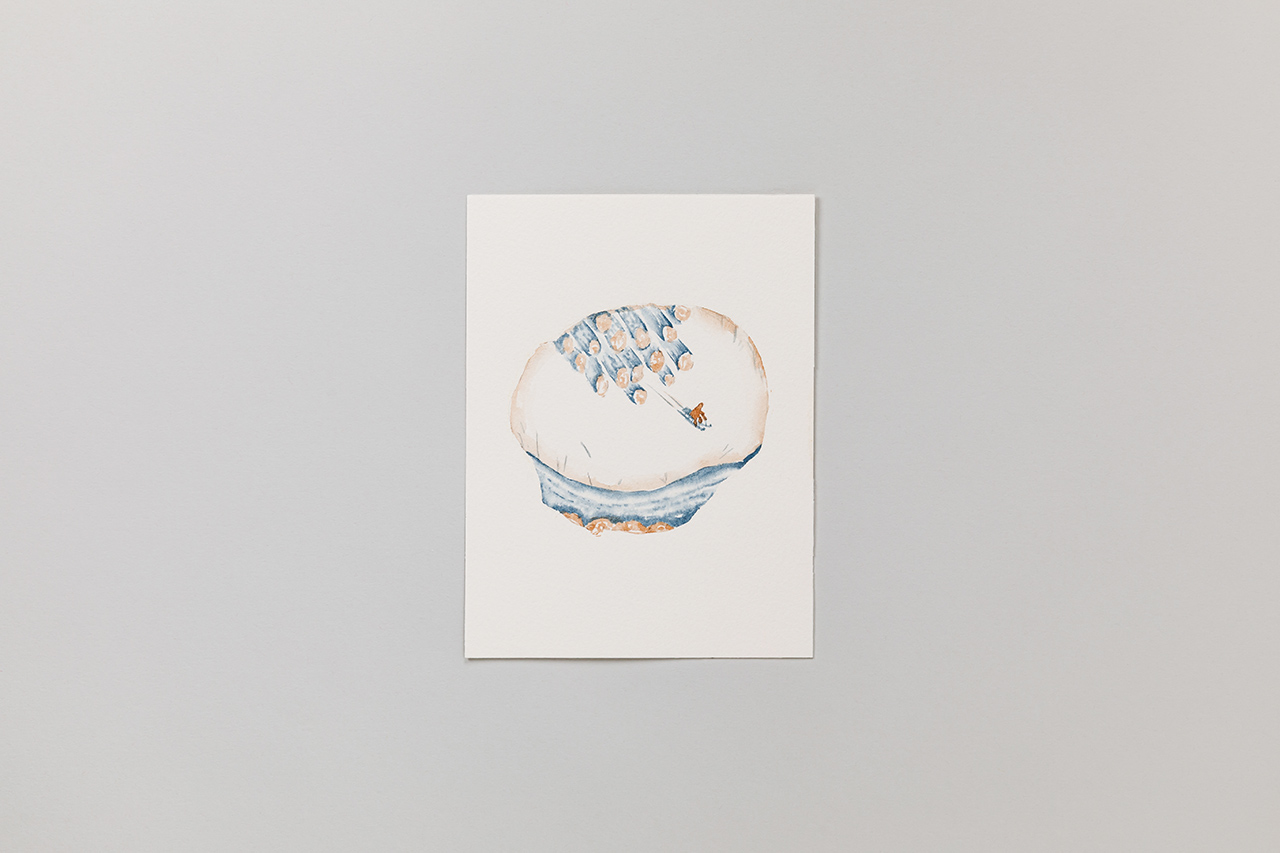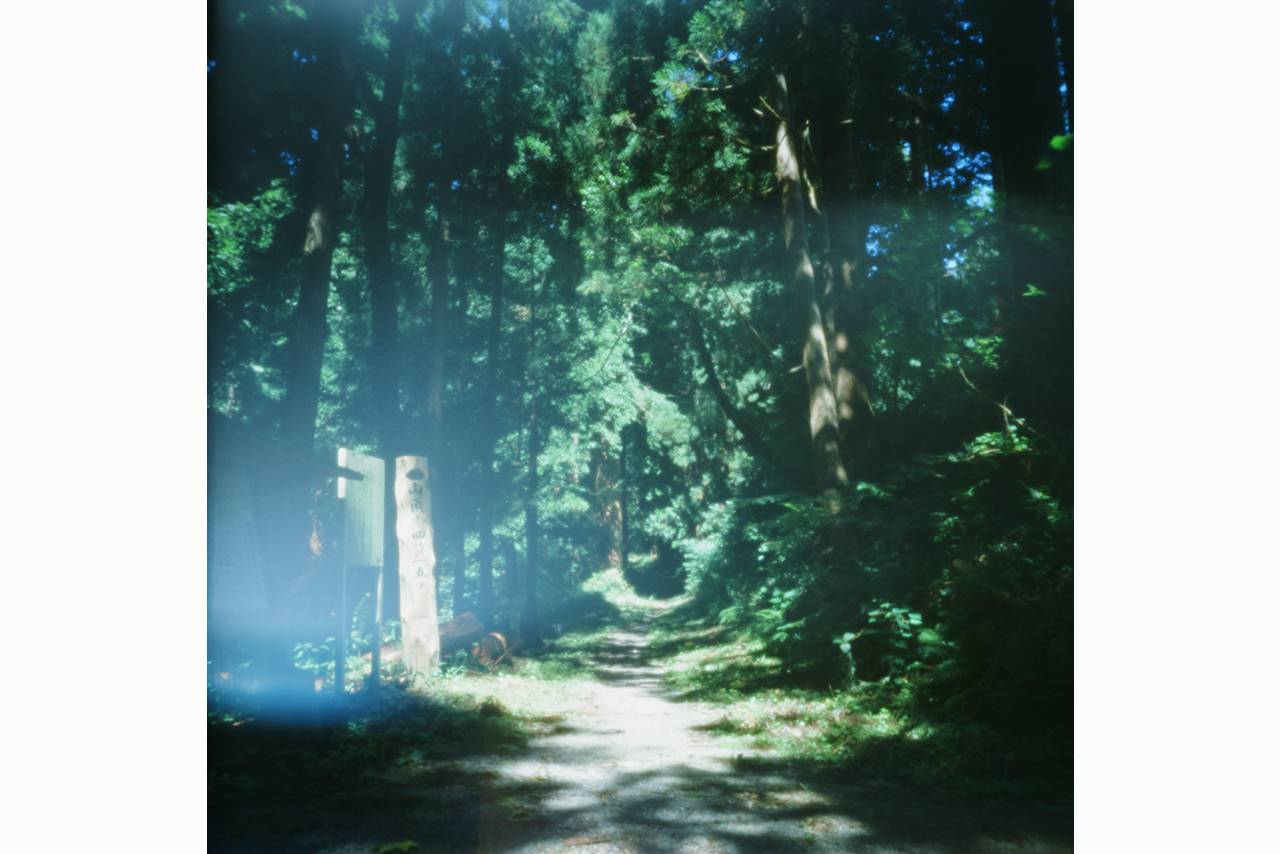津軽・南部地方の山の手仕事を取材し、人びとのことばをテーマに描いたドローイングシリーズ。マタギ(猟師)や木地師、漆掻きとその道具を作る鍛冶屋を訪ね、彼らが山や木から読み取るサイン、かつて誰かが口にしたことづてを取材した。自然と対話する彼らと私の手仕事を呼応させるため、作品には自ら採集した土と栽培した藍の葉から抽出した2種の絵具を使用した。取材では自作のピンホールカメラを使用し、「手で作る」ように土地と人びとを写真に記録した。
—
「積層の器 ことづての声」
手仕事について人と話せば、作り方や材料、風土の事、誰に教わり、作った物をどう捉えるか、そんな話になる。土や木を加工する手仕事めいた木版画をする私にとって、手を動かし思考する言葉は共感や手掛かりを与えてくれる。そして話し手の声から、積み重ねてきた創意工夫や伝わってきた誰かの言葉が推察され、個人の歩んだ事実という支流が、源の知れないことづての底流に続いているように思えるのである。
手工芸は大抵、使う環境に合わせて身近な天然素材で作られ、その土地の人と自然とを関係付ける道具となる。北極圏に住むサーミの人びとの場合、古来遊牧してきたトナカイから取る毛皮は、時に-40度にもなる厳しい冬の寒さから身を守る為の衣服となった。身近な自然の形を借りて作った道具で、その環境から身を守るのだ。サーミの人びとから話を聞いたように、厳しい自然と共にある手仕事を母国で見聞したいと考えた時、行く先は雪国の他なかった。私は津軽で、並々ならぬ積雪を体験してきた人びとから読み取れる何かを期待して、手工芸や山仕事に関わる方々を訪ね、時にはワークショップの中で、彼らの声に耳を傾け、その言葉を書き留めた。後述の言葉の断片は、こうして記録した言葉のほんの一部である。
− 見聞きした事の幾つかを取り上げてみる。…
このエッセイの全文は記録集『土のことづて』に収められています。
発表した展覧会
2022年11月26日-12月18日〈積層の器 ことづての声〉, ギャラリーパルク, 京都
2020年4月18日-8月31日 〈The Future is in Nature〉, ルオムの森, 群馬
This is a series of drawings about people’s words based on the handwork of the mountains of Tsugaru and Nanbu regions in northern Japan. I visited a Matagi (hunters) as woodturner, a lacquer tapper and a blacksmith who make lacquer tap tools. I interviewed them about the signs they read from mountains and trees, and the words someone once said. In order to correspond my handwork with those who interact with nature, I used two kinds of paints extracted from soil collected by myself and indigo leaves I cultivated. During the interview, I used a self-made pinhole camera to record the land and people in photographs as if they were “made by hand.”
–
A Vessel in Layers – The Voice of Lore
When you talk with someone about handicraft, the conversation naturally leads to materials, climate, how objects are made, and how craft is taught. As someone who makes woodblock prints using wood and soil in a manner that mirrors handicraft, I gain a sense of sympathy and insight from its language of thinking while working with one’s hands. From the speaker’s voice, we can infer both the cumulation of ingenuity and a language inherited from others who have come before. I believe that the individual is a tributary that flows into the continuous, collective undercurrent of lore.
Handicrafts are often made of natural materials that are readily found in the surrounding environment. They become tools that connect people to the land. In the case of the Sami people of the Arctic Circle, the fur of the reindeer, which they have herded since ancient times, has become the clothing that the Sami use to protect themselves from the severe winter cold, which can reach as low as -40 degrees Celsius. They use the naturally occurring shapes in their surroundings to create tools that protect them from their environment.
As I heard from the Sami people, when I sought out handicrafts born of severe conditions in my home country, I had only to go to snow country. I hoped to glean something from the people who have experienced the extraordinary snowfall of Tsugaru, lending my ear to their voices and writing down what I heard during workshops and after visiting people involved in handicrafts and mountain work. The excerpts above are just part of the stories I recorded in this way.
Below I share experiences from my research..
The whole of this essay is published in the document book “Lore of the Land“.
Translated by Queen & Co.
Copyright © Haruka Furusaka
These works were shown at the following exhibitions:
“A Vessel in Layers – The Voice of Lore”, Gallery Parc, Kyoto, Japan, 26 Nov.-18 Dec. 2022
“The Future is in Nature”, Luomu no Mori, Gunma, Japan, 18 Apr.-31 Aug. 2020

























